Why write such a specific article?
How should the website for a metalworking company be different from any other website
for a B2B company?
I have been developing and optimizing websites for the metalworking industry
for 10 years and I have often seen how this resource is underestimated and used
incorrectly.
By contrast, investments in traditional advertising are preferred in the manufacturing
sector, i.e. trade fairs, brochures, product sheets, publications in specialist
magazines, etc.
As we will see in this article, but you probably noticed it already on your own,
over the years, traditional advertising costs more and converts less.
Cost is not the only problem of traditional advertising, but the difficulty in
measuring its return on investment. If you want to deepen this topic I will publish
soon the article Metalworking industry: how to use
online advertising successfully.
Leave here your email address and I will notify you as soon as the article will be available.
You will find many surprising revelations in reading this article, all the result
of my direct experience.
Let's start immediately with the first one: a well-designed website can bring
many customers to a B2B company in the manufacturing sector, many more customers
than all the fairs and agents put together.
And above all spending much less or nothing.
We sell industrial machinery but our website does not bring us any customers.
In our sector the website is useless, it is much more important to go to fairs.
We also tried to do some advertising on Google, but we only get worthless contacts.
I heard sentences similar to the previous ones many timers and every time those
who have pronounced them, after setting up an ad-hoc digital strategy, have changed
their mind.
I guarantee you that none of my clients today would dream of going back.
Would you would do it, if by reducing your advertising budget by 90%, you had tripled quote requests?
What if by keeping the same budget you had tenfolded quote requests?
I bet I have your attention now.
In the following I will explain to you what characteristics the website of a
manufacturing company in the metalworking sector must have to be a magnet
for customers.
- How should the pages be structured?
- How should the navigation schema be designed?
- How should the copy be written?
As I anticipated to you at the beginning, all I will write is not by hearsay, but it’s
the result of decades of experience in the sector.
On the other hand, I will not explain the usual issues you find covered in other more generalist articles, for example that the site must be fast, optimized, mobile first, etc. I take these technical prerequisites for granted, I trust that you have turned to a serious web agency for your website.
What is the website of a metalworking company for?
I tell you immediately that the answer "The website serves to make the company
known" is unfortunately not correct.
For years now, the corporate website has no longer been considered effective
for brand awareness (make your brand known).
Despite the huge investments that many companies plan for SEO (Search Engine Optimization),
to appear at the top of search engine results, leaving the responsibility of making
their products/services known to the website alone is a gamble today.
The following diagram shows how the website positions itself in the customer
journey (the path that leads a anonymous visitor to become a loyal customer).

The customer journey is a term used in marketing to indicate the route
the customer travels when establishing a relationship with the company over time,
both offline and online. It is practically the story of the relationship that is
established between customer and company.
- Brand awareness: the first corporate objective within the
customer journey is to make the company known, if they don't know
that we exist, they will hardly come to us.
- Brand consideration: the second phase in which a possible
customer passes is that of consideration, that is, she knows that we exist,
but she must choose between us and our competitors.
- Brand evaluation: the third phase includes both the sales
process and the evaluation made by our new customer about the quality of the
acquired product/service.
- Brand loyalty: getting the customer into the fourth phase,
i.e. loyalty, is the most complex thing today, as thanks to the Internet, users
easily discover new companies and quickly move on to the competition.
Obviously the fact that the website is able to cover the last three stages of
the customer journey it is true only in the hypothesis of a site made in
a workmanlike manner.
In the metalworking sector, the panorama is quite bleak: at best I see sites that
are able to cover the brand consideration, i.e. explaining their products
and services.
They also often do it wrong:
- publishing complex, barely comprehensible texts to their own engineers;
- using high-sounding and self-referential language of the type "we are
the leading company in the sector, blah blah blah ...", but which does
not show any real value to those who are trying to decide their supplier.
I will explain later the typical mistakes that are made and what are
the guidelines you should adopt to effectively transform your visitors into customers.
Before going into the website design in detail, I want to show you the role that
other communication channels have in the B2B sector.
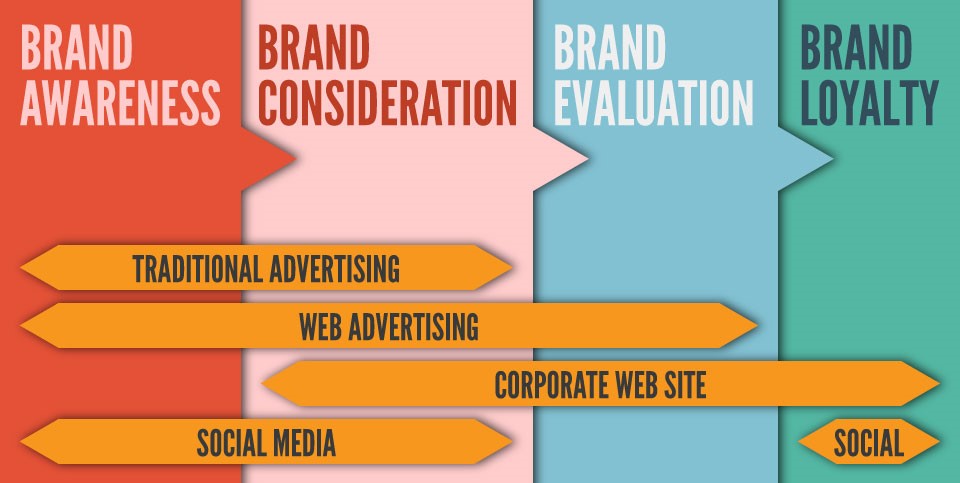
What is clear at a glance is that no communication channel, even if used to the
best, is able to cover all the phases of the customer journey.
You have to use at least two, three is better, four would be perfect.
I will just give you a couple of data, just to intrigue you, we will deepen these
topics in the next articles.
A customer in the engineering sector obtained with the web advertising
it only costs a few tens of euro.
This is nothing if you compare it to how much each customer costs you thanks to
a trade fair.
Where for B2B companies in the metalworking sector I had already created a website
and set up ad-hoc web marketing campaigns, after also adding content marketing and
social media marketing campaigns, we have increased the number of contacts
tenfold, as well as retaining already acquired customers.
Yes you got it right, we multiplied the number of requests for quotes by 10!
If you want to deepen this topic I will publish soon the article
Metalworking industry: how to generate a customers
flow using socials.
Leave here your email address and I will notify you as soon as the article will be available.
Funnel marketing: the website must facilitate the decision-making process of
the industry
We often speak in this period of funnel marketing, that is a
sequence of advertising actions designed to induce people to purchase through a
succession of phases. The term funnel is used, since it implies a marketing
action that initially involves a wider target, but that as it proceeds it becomes
more and more precise in identifying final customers.
But what many ignore is that the path is not determined by the seller,
but by the buyer.
It is useless to force your client into a decision-making process that is foreign
to her.
Your website must accompany and above all facilitate your customer in her
purchase process.
Those who have to buy a machine tool or must use the services of a subcontractor in the metalworking sector, do not do it with the same approach as those
who buy a book on Amazon.
For this reason, even before you start thinking about how your website will look,
you must have full knowledge of how the decision-making process of your target audience
is structured.
I guarantee you that if you design your website with a clear understanding of
funnel of your visitors, you will get sales performance that you
never imagined.
So what is the decision path of a company that decides to equip itself with an
industrial machinery or take advantage of a sector service?
The infographic below answers this question.

The most important thing to know are the questions that the customer asks in
each phase of the decision-making processes, in order to adapt the website to her:
not answering the questions that the customer asks is just as harmful as answering
those that she doesn’t ask.
Let's see them in detail following the diagram of the previous infographic.
- Need
- Analysis of the present: are my production needs met?
- Future opportunities: how can I improve production?
- Research
- Solutions evaluation: what solutions should I consider?
- Products/services: do I need a new industrial machine/service?
- Financial analysis: is a new machine/service financially affordable?
- Design
- Requirements analysis: what are the parameters that
I must consider to evaluate the solutions that are proposed to me?
- Criteria/priority: which are the evaluation criteria I should consider and how I have to prioritize them?
- Analysis of the alternatives: Are there alternative solutions?
- Solution selection: which solution will I adopt?
- Evaluation
- Suppliers analysis: what are the parameters that I
must consider to evaluate the suppliers?
- Criteria/priority: which are the evaluation criteria I should consider and how I have to prioritize them?
- Suppliers subset: which suppliers will I ask for an offer?
- Conclusions
- Proposals analysis: which proposals best reflect my selection
criteria and their priority?
- Proposal selection: which supplier do I choose?
- Purchase
The key to your website's success is all here: you must answer these
fateful questions at the exact moment your visitor asks them, neither before
nor after.
If your visitor is in the process of asking if she can improve her production, it
is useless for her to dissect your offer; instead help her understand the various
solutions that lie ahead.
If your visitor is in the process of deciding which suppliers to ask for an offer,
there is no point in inviting her to contact you; instead let her understand what
your surplus values are compared to the competition.
Designing a website that accompanies your visitor throughout the decision-making
process it is not easy, it takes a lot of experience and a thorough knowledge of
your target audience. But when you succeed, I guarantee that you will be inundated
with requests for quotes for your industrial solutions.
To make you understand the importance of knowledge of the decision-making process,
I give you a real example that alone is worth the effort of reading this
article so far.
In many cases we have brought many new customers to companies in the metalworking
sector, simply by not underestimating the question about ALTERNATIVES in the DESIGN
phase of the decision-making process (see the previous infographic).
Often in the field of the metalworking industry there are different types of technologies
and machinery that can be the solution to the same production problem.
If you produce one of these machines you must be able to intercept all those who
are looking for alternative solutions just because they don't know yours. For
example, if there are people who are looking for furnaces to heat treating metals
in a salt bath, perhaps they do not know the potential of vacuum heat treatments.
To intercept Internet searches for your competitors' solutions, you need
to talk about them on your website and then highlight the added value of
your alternative solution.
Re-read the last sentence carefully because there often lies the key to the success
of your online marketing.
Information architecture: how to convert visitors into customers
In the metalworking sector, the percentage of visitors who do not go beyond the
first page of the website they land (called the bounce rate) is on average around
40%: this means that almost one visitor out of two leaves the website after having
seen only one page.
In the category of showcase websites for the metalworking industry, a bounce rate
of less than 50% is considered a good result.
With some of our customers, where we have set up a complete digital strategy, we
sometimes have fallen below 30%, that is, more than 70% of visitors deepened their
knowledge of the products by browsing on further pages of the Internet site.
I'm sure you are now wondering what's the bounce rate of your current
website.
Discovering it is not difficult, if your website was not created by the last of
the web agencies, they surely have installed for you
Google Universal Analytics.
Once you've determined it, you already know that if your website bounce
rate is above 50% there is definitely something wrong.
We have also to add the complication that it is not possible to establish the
page on which a visitor will land, thanks to search engines we certainly cannot
assume that all of them will enter from the main door, that is from the home page.
So how do we not lose potential customers?
There are only two cases to consider and optimize:
- Visitors who land on the right page.
- Visitors who land on the wrong page.
What to do when a visitor lands on the right page?
By "right" page we mean the best page of your website in terms of relevance
to what your visitor is looking for.
In this case, considering that this may be the only page that will be read, the
golden rules that you must follow are:
- The page must be exhaustive, your visitor should not be
required to browse a further page for further information.
- The page must be conclusive, if your visitor decides to
convert (in our case ask for a quote), then the ideal is if she can do it on
the page on which she landed.
This last point must be carefully evaluated, you certainly cannot put
a contact form on every page of the site, otherwise you’ll seem a
spammer. Usually we rely on analytical data to make the decision and in some cases
we build an ad-hoc landing page.
If you want to deepen this topic I will publish soon the article
Metalworking industry: how to use online advertising
successfully.
Leave here your email address and I will notify you as soon as the article will be available.
What to do when a visitor lands on the wrong page?
Let’s divide the "wrong" pages into three categories and see
the best practices for each of them.
- The page is about an irrelevant product/service.
- The page is too generalistic.
- The page is about a similar product/service.
When the page the visitor lands on concerns a irrelevant product/service,
make sure that the visitor can reach the "right" page intuitively and
at the most with a click.
Generalist pages are for example the home page or pages that
group products into categories: also in this case make sure that the visitor can
reach the "right" page quickly and intuitively.
Often those looking for solutions for industrial production are not necessarily
aware of the machinery they would need. In cases where your visitor knows the problem
but not the solution, it is important to provide her with an alternative exploration
path that does not immediately take her to the machinery you want to sell her, but
rather guides her step by step towards the final solution.
There is a phrase that I like very much and I keep it well printed in my mind
when I do marketing: those who have to buy a drill do not really need a drill, but
a hole.
Think about it carefully when you would design your new website.
For example, if your visitor is looking for a solution in the aeronautical sector
to combine materials using heat and pressure at the atomic level, maybe she does
not know the existence of diffusion bonding furnaces. In this case you
have to intercept these customers by designing an alternative and complementary
navigation scheme to the main one, which initially asks them the sector
in which they work and after guides them towards the solution they are looking for.
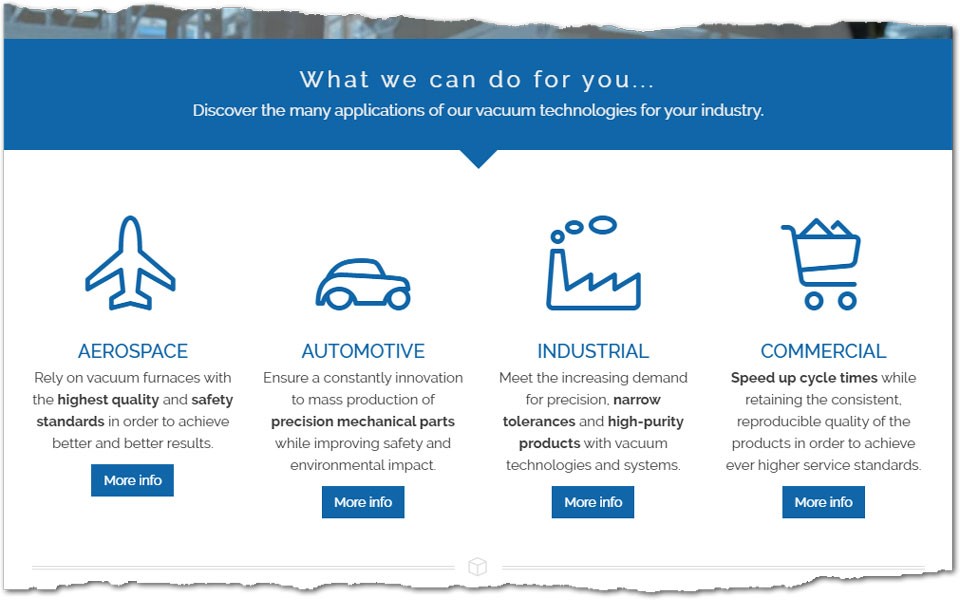
The third case concerns those who land on a page of the website which, despite
being relevant to what they are looking for, is not the right one. It is important
in this case to prevent the visitor from wasting time on the wrong page and to divert
her as soon as possible to the right one.
For example, if the visitor is looking for assistance for vacuum furnaces and
by mistake she landed on the new furnaces catalog, if you insist on selling her
a furnace you will certainly miss her: immediately make sure, at the top of the
page, that she was not instead looking for assistance and if necessary invite her
to go to the right page.
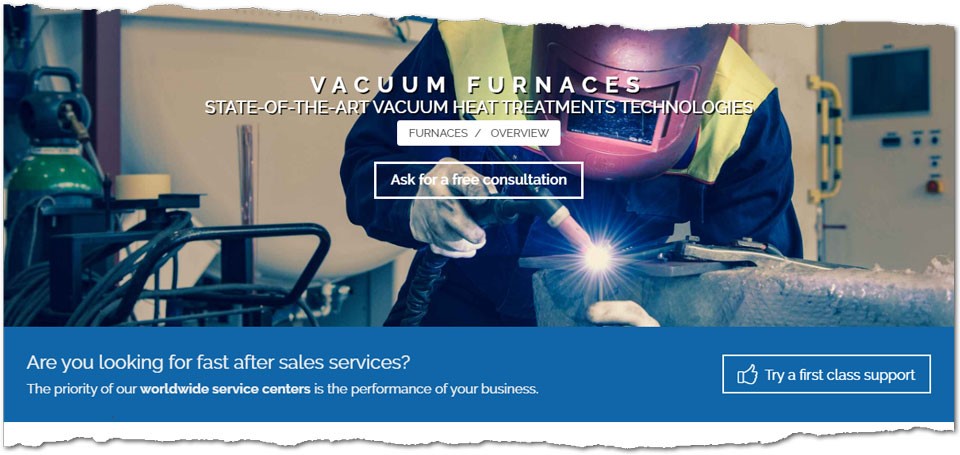
In all three of the previous cases it is also worth thinking about why the visitor
landed on the wrong page, especially if the analytical data of the site show that
this happens more often than necessary.
It could be the symptom of a wrong (or non-existent) search engine optimization.
I will deal with this topic in the article I am writing
Metalworking industry: how to get on top search engines
results.
Leave here your email address and I will notify you as soon as the article will be available.
For now, let’s continue to work on how to keep the attention of those who
land to our website and how to turn most of them into paying customers.
Copywriting for the metalworking industry: keeping attention high
2 seconds is the average time it takes a visitor to decide if she has landed
on the right website.
5 seconds is the additional time that the visitor takes to read the page on which
she landed to decide if the website deserves her further attention.
Compared to the printed word, the attention levels on the web are much lower.
The solution is to structure the texts according to the scheme of the inverted
pyramid, that is, starting with the conclusions, providing information
to support them, going into details and only at the end, listing the premises that
led to the conclusions.
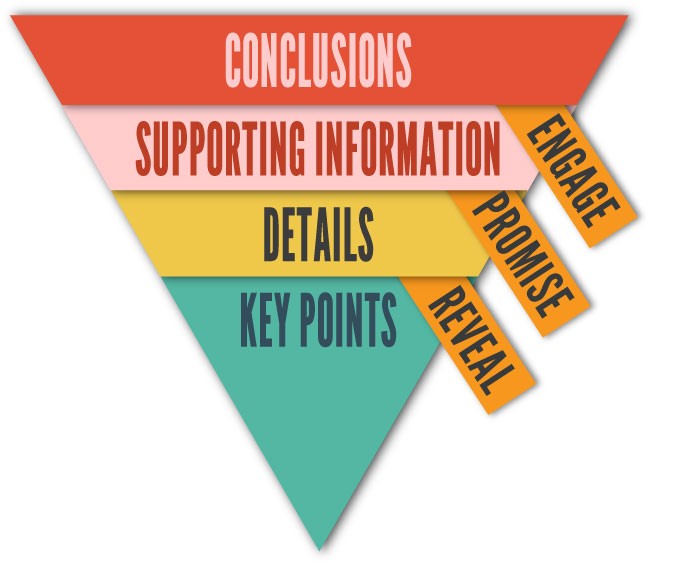
Let's see how the paradigm of the inverted pyramid is applied in the web page of one of our customers that sells welding chambers for air sensitive materials.
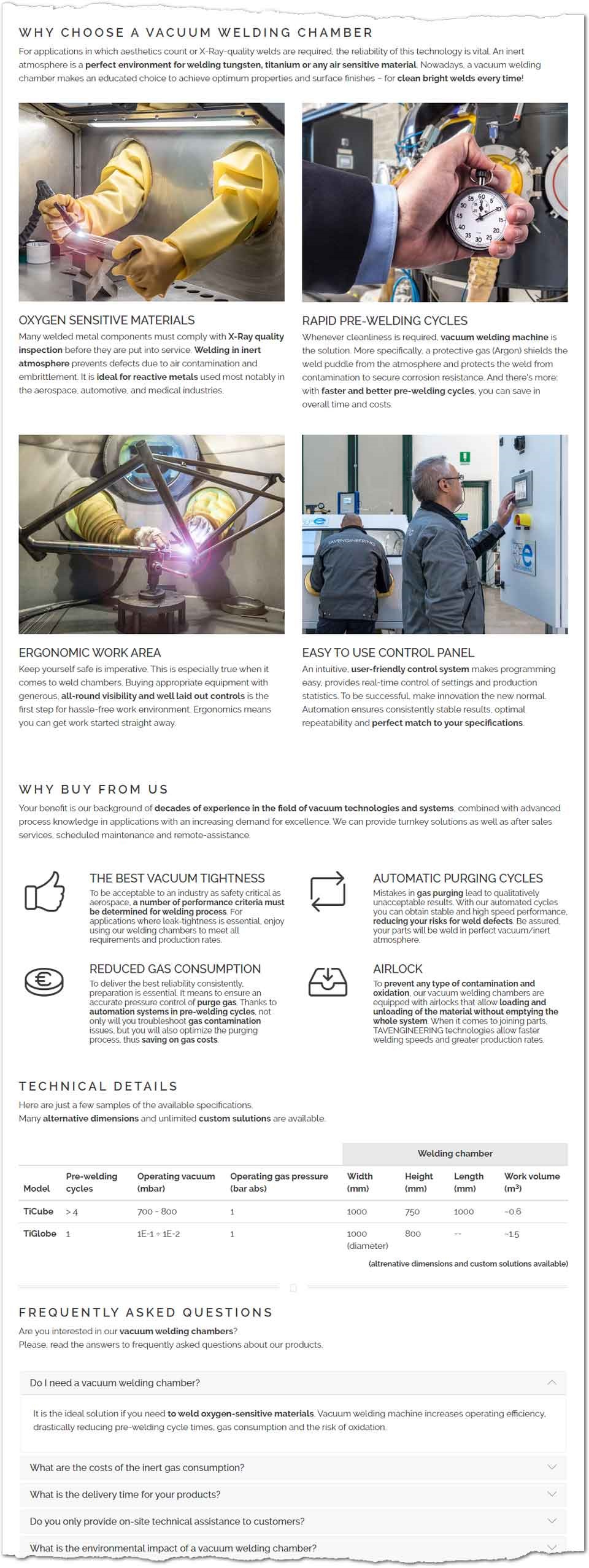
The template is the following (from top to bottom):
- Benefits: list and explanation of the benefits that the
customer should obtain regardless of the supplier she will contact. Self referencing
is carefully avoided in this section.
Here we talk about holes and not about drills, remember?
- Offer: list of reasons she should trust us to obtain the
aforementioned benefits. This is the time to be self-referenced.
- Technical details: if the reader has come this far, it
is time to entice her with the technical details.
- Frequent questions: if there are still doubts, a list of
FAQs.
This is obviously just an example, the right copywriting structure must be studied
ad-hoc according to the products and the target audience.
Conclusions
The web in industry is currently very undervalued.
The website of a metalworking company can capture many customers, many more than
fairs, magazines and brochures put together. Especially by spending a lot less.
To obtain these results you must first become aware of the huge opportunities
out there waiting for you and subsequently create a well-conceived platform
for acquiring online customers.
Forget the usual self-referential and self-celebrating language, on the web it
not only doesn't work, but it even annoys.
The copywriting of your website doesn't has to be the copy and paste of your brochures.
- Try to cover the whole of the customer journey: make yourself
known by attracting visitors, publish useful and relevant information, offer
them a simple experience to ask for a quote and finally retain them by giving
them reason to return.
- Study the decision process of your customers and adapt
the website to it: anticipate their questions and answer them fully.
- Apply simple and intuitive navigation paths, make sure
that users are always able to achieve what they are looking for in just one
click.
- Create exhaustive and complete pages, because the page
your visitor lands on may be the only one she will look at.
- Keep their attention high, don't bore your visitors with unnecessary
or irrelevant information, structure the copy following the scheme of the
inverted pyramid.
I do not pretend to have examined all aspects of the topic, but I would be happy
if in this long article I had given you the right ideas from which to start designing
or even just optimizing your website.
In the industry sector, well-made websites can be counted on one hand and for well-done
things, by now you have understood that I don't mean beautiful, but functional
to their primary objective: a website has to bring dozens, if not hundreds
of new customers every month.
Start today to study the best digital strategy for your company, do it yourself
or rely on a professional, it's time to become a protagonist of the web in
your sector.
If you want to ask me some questions, write in the comments section.
Alternatively if you want us to start thinking about
it together, write to me without obligation using the contact form below.
